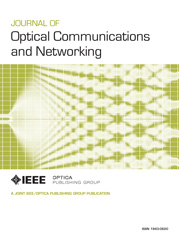Journal of Optical Communications and Networking (JOCN)
Special Issue on Optical Networking for 5G Mobile and Wireless Communications
Submissions Open: 15 April 2016
Submission Deadline: 15 June 2016
Future 5G networks need to support unprecedented requirements for the wireless access connection, targeting cell throughput capacities in the range of 10-100Gb/s and peak access rates per user or even per connected device on the order of 1Gb/s, while maintaining low latency targets to support real time services. At the same time, a dramatic paradigm shift is observed in Internet usage with multimedia traffic, especially video, and cloud services, occupying the largest share of the available capacity while changing dynamically over time and location based on the user community's social and mobility habits. Certainly it will be extremely challenging for network designers to develop the solutions to support such new network targets and services requirements for fast moving mobile users. The relevant topics are the focus of intense efforts worldwide by major companies and research centers, but also among the activities of major government funded projects.
For the evolution towards 5G, it is envisioned that optical networking will play a major role in supporting the requirements, while reducing the deployment costs through the introduction of novel converged Fibre Wireless (FiWi) networks with fundamentally new PHY layer architectures, data link and network layer functionalities and interfaces with the service layer. The target for the optical network is to support the distribution and collection of millimeter wave radio signals, enabling the greatest flexibility for the accommodation of the wireless network requirements, while reducing the cost of the wireless access points (i.e. remote radio heads/remote antenna units). The overall network design should take into consideration the control and monitoring functionalities and capabilities of the network, and is envisioned to be based on software defined network (SDN) concepts and advanced virtualization capabilities with the use of an elastic flexible transport infrastructure and network function virtualization (NFV) elements.
In this special issue of JOCN, contributed papers together with several invited articles targeted to specific R&D efforts will provide complete coverage of the 5G topics for which optical networking can play a key role. The special issue will serve as a key reference for researchers who would like to get up-to-date views on the latest research efforts.
Manuscripts must be prepared according to the usual standards for submission to the Journal of Optical Communications and Networking and must be uploaded through OSA's electronic submission system, (/jocn/journal/jocn/author.cfm), specifying from the drop-down menu that the manuscript is for the Feature Issue on Optical Networking for 5G Mobile and Wireless Communications.
Special Issue Editors
Frank Effenberger, FutureWei Technologies, USA
June-Koo Rhee, KAIST, South Korea
Ioannis Tomkos, Athens Information Technology Center, Greece

